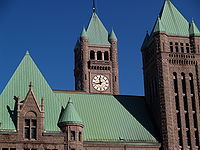
Copper Tube Corrosion Factors
~ Copper's Inherent Resistance to Corrosion Renders It a Versatile Material

Copper's Corrosion Resistance
Copper has uses in virtually every industry. Its corrosion resistance has significant benefits. Copper is fantastic for piping because it is not quite as heavy as other applications, has durable strength, but most importantly because it is highly resistant to corrosion.
Some architectural buildings have been roofed with copper, ultimately leading to a green tint after many years. But once this tint has been achieved, the copper no longer corrodes and the roof remains for years to come.
Copper's slow, General Corrosion (Cuprosolvency) forms a patina in a reaction with water. This initial patina corrosion protects pipes against further corrosion and damage. Copper is not prone to cracking because of its flexibility and is not damaged by intense cold, so copper pipes are used extensively in the refrigeration industry.
Does anything you see need improvement? Please email us! improvement@coppertubecoils.com

Data About Copper Corrosion
 Copper develops a what is called a, "Cuprous Oxide Layer." The COL actually forms a protective shield on the surface of the copper and prevents further corrosion. Most of the following forms of corrosion can be avoided by using recommended industry techniques found at such organizations such as the American Water Works Association.
Copper develops a what is called a, "Cuprous Oxide Layer." The COL actually forms a protective shield on the surface of the copper and prevents further corrosion. Most of the following forms of corrosion can be avoided by using recommended industry techniques found at such organizations such as the American Water Works Association.
Exceptional Corrosion Incidents
Cold Water Pitting. Also known as "Type I pitting." This form of corrosion is very rare (as are most forms of copper corrosion). Before the 1970s, copper tubing was manufactured using certain compounds that included carbon and resulted in carbon films on the inside of the tubes. Through a sophisticated imbalance of oxygen, small pits would form in the side of the tube, earning it the term "cold water pitting."
Erosion Corrosion This is also called impingement damage, which is due largely to the medium moving through the tube being far too fast for the normal protective cuprous oxide layer (COL). The COL is slowly ripped off of the inside of the tube allowing further slow (normal) corrosion to take place.
Oxygen Concentration Cell Corrosion. This form of corrosion usually takes place when there are heavy solids (such as ferrous-base materials) dissolved in the water or fluid. Filtering the fluid to remove the ferrous-base materials resolves this issue. Distilled or deionized water, for example, should not cause this form of corrosion.
